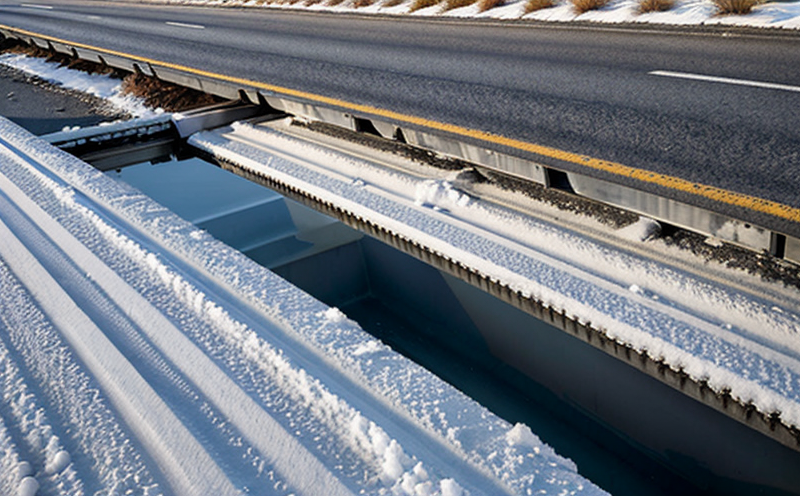Verifying that construction materials used in roads, bridges, and pavements are resilient to freeze-thaw damage
The Ultimate Protection for Infrastructure Verifying Construction Materials Resistance to Freeze-Thaw Damage
As the backbone of modern infrastructure, roads, bridges, and pavements bear the brunt of harsh environmental conditions, including extreme temperatures, precipitation, and humidity fluctuations. Among these, freeze-thaw cycles pose a significant threat to the durability and safety of construction materials used in infrastructure development. Prolonged exposure to repeated freezing and thawing can lead to devastating consequences, such as material degradation, cracking, and structural instability.
In this article, we will delve into the importance of verifying that construction materials used in roads, bridges, and pavements are resilient to freeze-thaw damage. Our team at Eurolab has developed a state-of-the-art laboratory service designed to help businesses ensure the long-term integrity and performance of their infrastructure projects.
What is Freeze-Thaw Damage?
Freeze-thaw damage occurs when water seeps into construction materials, such as concrete or asphalt, during wet periods and freezes upon cooling. As ice forms within the material, it expands, causing micro-cracks to develop in the surrounding structure. When temperatures rise, the frozen water thaws, leaving behind empty cavities that can weaken the material over time.
Repetitive freeze-thaw cycles can lead to catastrophic consequences, including
Reduced structural integrity
Cracking and spalling of concrete or asphalt surfaces
Increased maintenance costs due to frequent repairs
Potential loss of life in critical infrastructure
Why is Verifying Construction Materials Resistance to Freeze-Thaw Damage Essential?
Verifying that construction materials used in roads, bridges, and pavements are resilient to freeze-thaw damage is crucial for several reasons
Key Benefits of Our Laboratory Service
Ensure Infrastructure Safety By verifying the freeze-thaw resistance of construction materials, you can guarantee the safety and integrity of your infrastructure projects.
Reduce Maintenance Costs By identifying potential vulnerabilities early on, you can minimize maintenance costs associated with frequent repairs and replacements.
Extend Infrastructure Lifespan Our laboratory service helps ensure that your construction materials will withstand harsh environmental conditions, extending the lifespan of your infrastructure assets.
Compliance with Regulatory Requirements Many regulatory agencies require verification of freeze-thaw resistance as part of the project approval process. Our laboratory service ensures compliance with relevant standards and regulations.
How Does Our Laboratory Service Work?
At Eurolab, our expert team employs advanced testing methods to assess the freeze-thaw resistance of construction materials used in roads, bridges, and pavements. We use state-of-the-art equipment and follow internationally recognized standards (e.g., ASTM C 666/C 157) to ensure accurate and reliable results.
Our comprehensive laboratory service includes
Material sampling and preparation
Freeze-thaw cycling tests
Physical and mechanical property assessments
Non-destructive testing (NDT)
Frequently Asked Questions
Q Why is freeze-thaw damage a significant concern in infrastructure development?
A Freeze-thaw damage can lead to catastrophic consequences, including structural instability, reduced lifespan, and potential loss of life.
Q How do I know if my construction materials are resistant to freeze-thaw damage?
A Our laboratory service at Eurolab provides a comprehensive assessment of your construction materials freeze-thaw resistance using advanced testing methods.
Q What types of construction materials can be tested for freeze-thaw resistance?
A Our laboratory service is suitable for various construction materials, including concrete, asphalt, cement-based products, and more.
Q How long does the testing process take?
A The duration of our laboratory service varies depending on the type of material being tested. However, we strive to provide results within a reasonable timeframe, ensuring minimal disruption to your project schedule.
Conclusion
Verifying that construction materials used in roads, bridges, and pavements are resilient to freeze-thaw damage is an indispensable aspect of infrastructure development. Our laboratory service at Eurolab empowers businesses to ensure the long-term safety and performance of their projects.
Dont let freeze-thaw damage compromise your infrastructure assets. Contact us today to schedule our laboratory service and take the first step towards safeguarding your investments.
Additional Resources
Learn more about our state-of-the-art laboratory services
Download our whitepaper on Freeze-Thaw Resistance in Construction Materials
Explore case studies of successful projects that utilized our laboratory service
Stay informed, stay protected.
-
Simulating the effects of repeated freeze-thaw cycles on construction materials
-
Testing materials for their ability to withstand the expansion and contraction caused by freezing and thawing
-
Ensuring that concrete, brick, and stone retain their integrity when subjected to freezing temperatures followed by thawing
-
Evaluating the ability of materials to resist cracking, spalling, or delamination after freeze-thaw exposure
-
Testing how materials like asphalt and cement react to temperature fluctuations and freezing water
-
Simulating winter conditions to assess how materials perform in regions with extreme cold and fluctuating temperatures
-
Ensuring that construction materials maintain their strength and structure when exposed to freeze-thaw conditions
-
Testing the resistance of waterproofing and sealant materials to freeze-thaw cycles
-
Simulating the effects of wetting and drying, combined with freezing and thawing, on construction materials
-
Testing for the ability of materials to resist moisture absorption and freezing-related damage
-
Evaluating the durability of materials used in exterior applications such as roofing, facades, and pavements under freeze-thaw conditions
-
Ensuring that materials used in foundations and basements are resistant to water infiltration and freeze-thaw cycles
-
Verifying that materials used for building envelopes can resist cracking, erosion, and damage from freezing conditions
-
Testing how freeze-thaw cycles affect materials used in high-altitude or northern climates
-
Simulating freeze-thaw cycles in combination with other environmental stresses to assess material resilience
-
Testing for changes in the dimensional stability of materials when exposed to freezing and thawing
-
Verifying the performance of materials used in landscaping and exterior finishes after freeze-thaw exposure
-
Ensuring that frozen soil and other environmental factors do not damage foundation materials during freeze-thaw cycles
-
Testing the ability of materials to resist degradation due to the crystallization of moisture within the material during freezing
-
Simulating the effects of repeated freeze-thaw cycles on materials in coastal areas where saltwater may accelerate deterioration
-
Testing the performance of thermal insulation materials under freeze-thaw conditions




